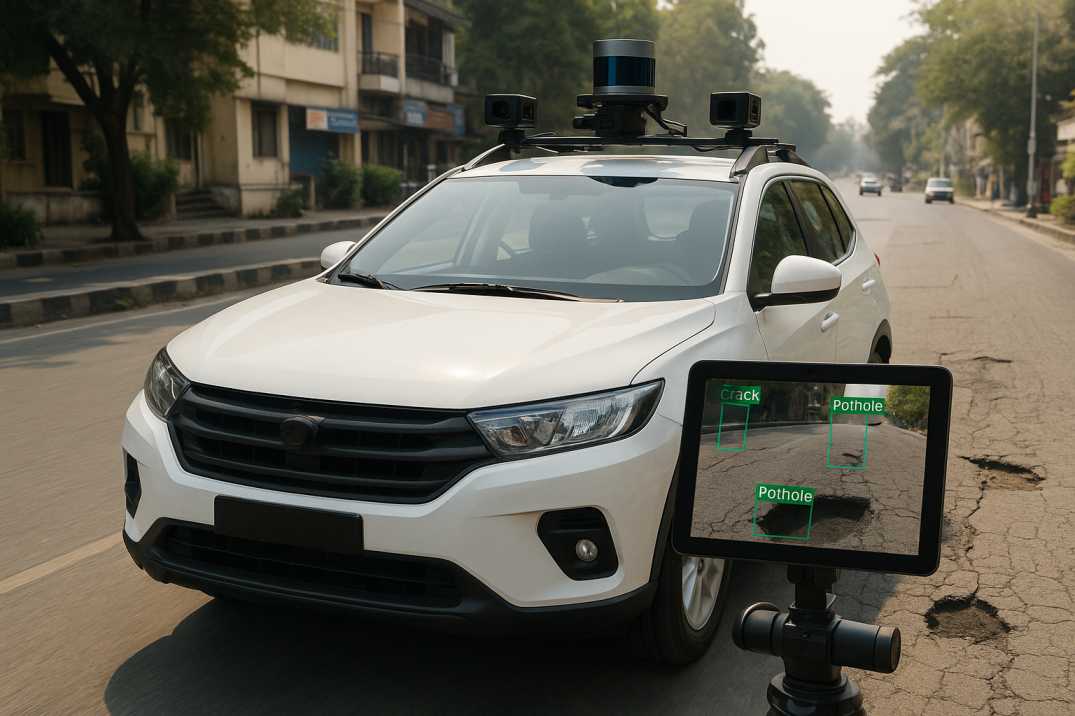Contact Us
RoadVision AI
Private Limited
Office No. 308 & 310, B Block
Ansal Chamber - 1, Bhikaji Cama Place,
Near Engineers India Limited (EIL) Bhawan, New Delhi - 110066
© 2024 | RoadVision AI | All rights reserved
India’s road network spans over 6.3 million kilometers, making it the second-largest in the world. Maintaining these roads in safe and serviceable condition is a continuous challenge for local governments. Traditional manual inspections are time-consuming, expensive, and prone to subjectivity.
The emergence of mobile-based road condition data collection systems, powered by AI road condition monitoring and automated pavement condition survey technology, is transforming how road asset management in India is conducted. These systems comply with Indian Roads Congress (IRC) guidelines, such as IRC SP:16, IRC SP:21, and IRC:82, ensuring data quality for accurate pavement management decisions.

Mobile-based road condition monitoring uses vehicles equipped with AI-enabled cameras, GPS, and sensors—often integrated into smartphones—to collect pavement data while driving. The collected data covers:
With AI pavement condition monitoring and AI pavement condition survey tools, these data sets are processed automatically to produce actionable maintenance recommendations.
Traditional road surveys often require months to cover large networks. With mobile-based systems, municipalities can capture 200–300 km of road data per day.
By replacing extensive manpower with automated devices, mobile-based methods can cut costs by up to 60%.
AI pavement design tools ensure consistent, objective results that align with IRC compliance requirements.
Data is geo-referenced, allowing authorities to visualize and prioritize repairs within digital road maintenance systems.
According to IRC SP:16 (Guidelines for Surface Evenness of Highways) and IRC SP:21 (Manual for Maintenance of Bituminous Surfaces of Highways), pavement condition monitoring should assess structural and functional characteristics including:
For urban roads, MoRTH’s Pavement Maintenance Guidelines recommend regular automated pavement condition surveys to plan preventive maintenance before damage escalates.
Authorities conducting road inventory inspection can refer to RoadVision AI’s Road Inventory Inspection page for technology-driven approaches.
AI road condition monitoring uses machine learning to detect and classify pavement defects from video and sensor data. This not only accelerates inspections but also enables predictive maintenance planning.
With predictive analytics, AI pavement condition monitoring tools can recommend targeted repairs before roads reach critical deterioration levels, saving public funds and minimizing service disruptions.
See how AI transforms road safety on the Road Safety Audit page.
Digital road maintenance systems centralize all road condition data into a single dashboard for municipal engineers. Features include:
Discover how traffic data influences maintenance at the Traffic Survey page.
For real-world applications, explore the Case Studies section.
Mobile-based road condition monitoring is set to become a standard practice for road asset management in India. By integrating AI pavement condition survey, predictive analytics, and digital road maintenance systems, local governments can enhance road safety, reduce maintenance costs, and comply with IRC and MoRTH guidelines.
RoadVision AI is revolutionizing the way we build and maintain infrastructure by leveraging the power of AI in roads to enhance road safety and optimize road management. By utilizing cutting-edge roads AI technology, the platform enables the early detection of potholes, cracks, and other road surface issues, ensuring timely maintenance and improved road conditions. With a mission to create smarter, safer, and more sustainable roads, RoadVision AI ensures full compliance with IRC Codes, empowering engineers and stakeholders to make data-driven decisions that reduce costs, minimize risks, and improve the overall transportation experience.
Read more on RoadVision AI’s Blog and take the next step toward smarter infrastructure.
Book a Demo with us to see how our mobile-based road condition monitoring solutions can transform your municipality’s maintenance strategy.
Q1: How often should road condition monitoring be done in India?
As per IRC SP:16, highways should be surveyed annually, while urban roads should be inspected every 6 months for optimal maintenance planning.
Q2: Is mobile-based monitoring accurate enough for official reports?
Yes, when calibrated and compliant with IRC guidelines, mobile-based systems produce data suitable for government-level pavement management reports.
Q3: Can AI pavement condition monitoring predict future road damage?
Yes, AI models can use historical and real-time data to forecast pavement deterioration trends, enabling preventive maintenance.